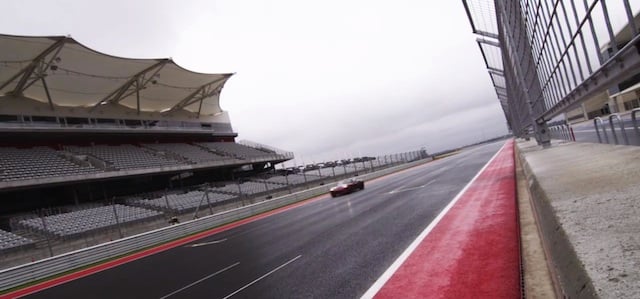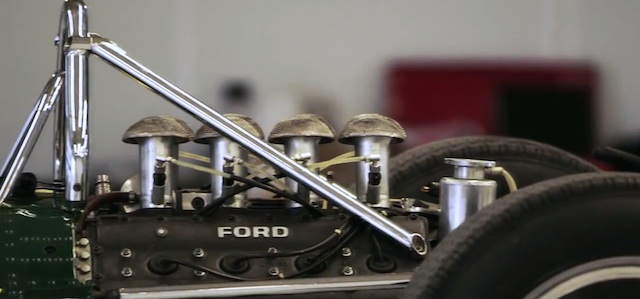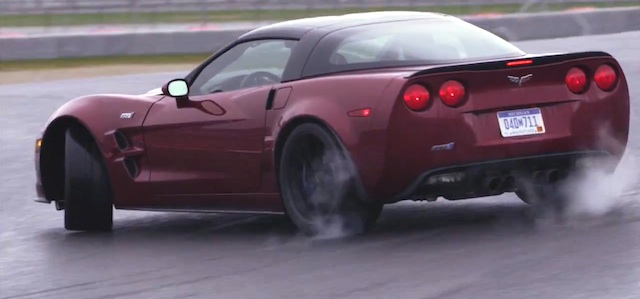 Over the course of a single decade, Grand Prix cars evolved from the front-motored Ferrari 246 that won the Monza Grand Prix in 1960, to the more contemporary winged warriors that we most often associate with the professional motorsport today. Aerodynamics of course did become of paramount concern to the sport, but it was the 1.5-liter displacement limit, established by the circuit during the ’61 racing season, that really brought on chassis and suspension development for the formula cars.
Over the course of a single decade, Grand Prix cars evolved from the front-motored Ferrari 246 that won the Monza Grand Prix in 1960, to the more contemporary winged warriors that we most often associate with the professional motorsport today. Aerodynamics of course did become of paramount concern to the sport, but it was the 1.5-liter displacement limit, established by the circuit during the ’61 racing season, that really brought on chassis and suspension development for the formula cars.
This is because Lotus’ Colin Chapman and others, with the strict engine size limit enacted, were forced to switch to car undercarriages as their primary focus. Indeed, of all of the 1960s’ Grand Prix players, it was Chapman and Lotus who developed the monocoque-style chassis that would replace the conventional space frame, allowing for much smaller-displacement engines at astronomically-high motor speeds to remain competitive.
 Five years after the 1.5-liter rule was put into place, the Grand Prix sanction raised the bar by increasing engine size limit to 3 liters for naturally-aspirated units, which left many race teams like Lotus without appropriate motors. Teams and builders like Coventry Climax experimented with such engine layouts as a 3-liter, 16-cylinder that was based on their already-existing, 1.5 liter V8, but this and BRM’s “H16” would prove too heavy, as the mill would only make it into the Lotus 43 for a single season.
Five years after the 1.5-liter rule was put into place, the Grand Prix sanction raised the bar by increasing engine size limit to 3 liters for naturally-aspirated units, which left many race teams like Lotus without appropriate motors. Teams and builders like Coventry Climax experimented with such engine layouts as a 3-liter, 16-cylinder that was based on their already-existing, 1.5 liter V8, but this and BRM’s “H16” would prove too heavy, as the mill would only make it into the Lotus 43 for a single season.
The H16 featured in the 43 race car not only proved to be a heavy engine, but an unreliable one to boot; driver Jim Clark was able to score one track victory using the H16-powered Lotus, but the engine would fail at literally every other racing event. It was at this point that Lotus’ Colin Chapman realized that he needed a better motor for the track, and in 1967 his search began.
The first two people who Chapman had consulted for the small-engine build were Cosworth engine company founders, Mike Costin and Keith Duckworth. Not too long before, Cosworth and the Ford Motor Company had successfully snagged an Indy 500 victory together, so Chapman was able to use some of his business savvy to secure an air-tight merger between Cosworth and Ford.
Soon after, development of an F2 racing engine began with one of Ford’s 4-cylinders as their base. From that block, Chapman and the Cosworth company were able to manifest a dual, overhead-cam, 1600cc race mill that used 4 valves per cylinder and created a substantial 400 brake horsepower at 9,000 RPM.
Chapman and Cosworth’s new engine was built to race sanction standards, setting the bar for a 3-liter V8 that would be introduced during the 1967 Grand Prix season. The engine’s block was cast entirely by Cosworth out of aluminum. The Ford-Cosworth 1600 mill, dubbed the “DFV” because of its dual-cam design, would be used by Chapman in his Lotus 49, F1 race car, and the motor was run to its max potential.
No doubt the Lotus 49 became Colin Chapman’s ultimate contribution to Formula One in the ’60s, but with a racing heritage equally informed by the likes of famed tuner, Bill Thomas and his long-deceased Cheetah, the Corvette nameplate has garnered just as much of a racing reputation as Lotus and the others. This is made evident in our featured clip from Road & Track, of a ’13 ZR1 running against Chapman’s legendary Lotus 49.
 In fact, many would be surprised to know that Carroll Shelby was one of the Vette Italia’s founding fathers, and Shelby himself had actually approached GM with the idea of building an Italian-bodied Vette for the buying market, long before the first 289 or 427 Cobra was ever produced.
In fact, many would be surprised to know that Carroll Shelby was one of the Vette Italia’s founding fathers, and Shelby himself had actually approached GM with the idea of building an Italian-bodied Vette for the buying market, long before the first 289 or 427 Cobra was ever produced.
It was because of the Chevy small-block’s balance of power and durability that builders/racers like Shelby preferred its presence under the hoods and trunk lids of the some of the world’s  fastest-production sports cars, and it was this same lesson that Colin Chapman was forced to learn with the DFV motor, along with the failure of the H16 that spurred its very creation.
fastest-production sports cars, and it was this same lesson that Colin Chapman was forced to learn with the DFV motor, along with the failure of the H16 that spurred its very creation.
For these reasons, both the supercharged ZR1 of today and the classic 49, Formula racer from yesteryear are flagships, representing their marques high-water point. Is it any wonder, then, that it’s so hard for us to choose which of the two represents racing history’s bigger milestone?


















